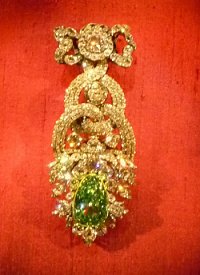The lure of the Dresden Green diamond.

The Dresden Green Diamond. Photo by X Rudi. Source: Wikimedia Commons
Are diamonds still a girl’s best friend? Recent press on the diamond industry has cast the stones into some disfavor, as the reality of corrupt negotiations and merciless syndicates has been revealed. But there is a good way around this political quagmire, and that is old diamonds. Really old ones. This month, one of the world’s best old stones — the Dresden Green diamond — makes its first visit to the United States, going on view (for a single day) at Harry Winston in New York before traveling to the Smithsonian Institution in Washington, D.C. Dug up prior to 1726, most probably in India, the Dresden Green was passed into the hands of Jewish merchants and eventually sold to Frederick Augustus II, elector of Saxony and kind of Poland (as Augustus III), for a sum so vast that he later had to beg off assisting the king of Prussia in military action because of the depletion of his treasuries. In 1768, the stone was placed in its current setting: a hat ornament. (What else would one do with a 41-carat, remarkably transparent, modified-pear-shaped green diamond more than one inch long?) During the centuries that followed, it remained in Dresden except during times of war, when it went to a vault outside town in the Königstein Fortress. The apple-green brilliant was carried off by the Soviet Trophies Commission at the close of World War II and spent a dozen years in Moscow but was finally returned to East Germany in the late fifties.
Beyond its history, what makes diamond fans swoon over the Dresden? Naturally occurring green diamonds — their remarkable color attributable to deep irradiation — are rare enough. But because documentation of the color of the Dresden Green antedates Marie Curie, we may be certain that this is the real deal, and the Dresden has been a gemologists’ Rosetta stone, the one that could be examined with modern techniques to understand better the physical structures of its coloration.
The Dresden Green has been called a sister of the Hope Diamond, donated by Harry Winston to the Smithsonian in 1958. “I always hoped that in my lifetime I would be able to witness the Hope Diamond and the Dresden Green on exhibit together,” says Ronald Winston, who has negotiated the loan of the German gem to the United States. But what’s in it for the city of Dresden? The stone will be “Dresden’s ambassador to the United States,” says the director of the city’s Albertinum Museum. “Now Dresden will take its place among the world’s sought-after museum destinations.” O.K., so Dresden’s no Bilbao. Still, the opportunity to see Dresden’s greatest remaining treasure, and to see it beside the most fabled jewel of them all, is an uncommon one. No pearl of greater price will be found on this earth.











